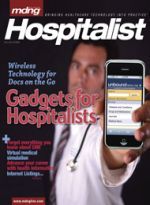Publication
Article
MDNG Hospital Medicine
TechSectors - Software: Anatomic 3D Avatar
Andre Elisseef of IBM's Zurich Research Lab explains how IBM's Anatomic and Symbolic Mapper Engine (ASME) enables physicians to visualize patient records using three-dimensional representations of the human body.
Andre Elisseef of IBM’s Zurich Research Lab explains how IBM’s Anatomic and Symbolic Mapper Engine (ASME) enables physicians to visualize patient records using three-dimensional representations of the human body.
How does the ASME system work?
Th e technology enables the use of a 3D model of anatomy to navigate and access medical information. It is mostly aimed at delivering three types of strategies to the end user. Th e fi rst is data summary, in which a set of organs highlighted on the model represents relevant information in a single patient’s history. Th e system also includes data access, in which you click on an area of the 3D model and it triggers a search over all the medical records stored in the system relating to that area. Th ere’s also data entry—when you type in free text, the system automatically tries to fi nd which concepts are related to that text, and it uses the 3D model as a way to guide the user throughout this concept. So, if you type “heart,” it will highlight the heart and ask whether you’re interested in the heart or in the periphery of the heart, or diseases of the heart, etc.
How can this technology be incorporated into an existing EMR system?
It’s somewhat separate from these systems. Right now, we’re working with a hospital to install the ASME system aside their current EMR system, and it will let the user switch from one system to the other. We’ll record how much the old system is used compared to the new system. So far, the idea is that it will be a layer to visualize, access, and index data. Th e data indexed is really the information about a single patient. So, if you have access to a database that stores these single patient records, then you can add this 3D visualization component and indexing on top of it. So, we’re discussing with other vendors to integrate this component into their solutions.
One of the ideals of the project will be to have it completely integrated into a browser, so you just need a database, and with the system, you can access the information with the appropriate access rights.
Do you foresee any compatibility issues?
Right now, we’re working with Denmark; the data there is pretty well shared among different hospitals, and it’s standardized. But we’re starting efforts to integrate interoperability into the system. So, one of our sub-projects is to integrate the [Integrating the Healthcare Enterprise] components into the project so we could have cross-sharing and data entering across diff erent applications.
What benefits can this technology provide to physicians and their patients?One benefi t for the physician is quick access to the relevant information. So, you click [on an area of the body where the patient has complained that] something is painful, and the system retrieves the relevant related information. The second thing, which started this whole process, is to provide to the end user a better way of accessing and using standards. The system is based on SNOMED (systematized nomenclature of medicine), which has more than 400,000 terms. The ASME project and components allow the user to enter free text, and the system will automatically annotate it with standardized terms. Th is should make it easier for the end user to follow standards.
How detailed is the 3D model?
We have a partner—Primal Pictures—that spent 15 years developing a 3D model that is pretty accurate. Right now, we have about 2,000 diff erent components; it could go up to 7,000. Th e project really takes all the diff erent small parts of the body and matches them to standardized concepts and to the medical records of the patient. Th e 3D model is fairly complex and covers many things. We’re still stuck at a certain resolution, so it doesn’t go down to the cell or gene expression level. Most of this model, especially the bones, is based on the Visible Human Project from the National Library of Medicine. It’s really precise and includes the lymph nodes, nerve sets, all the muscles and ligaments, and all the organs.
Can a physician obtain this technology now?
The project we’re working on with the hospital in Denmark is trying to answer the question, “We have this 3D model of the human anatomy and this way of accessing, rendering, and entering data; is it useful for the end user?” We should have the answer to this question by June or July 2008. Th en, we can move to making it available to a broader audience, which would fi rst be another set of hospitals, and then to general practitioners with more collaborative tools to work with patients and colleagues.






